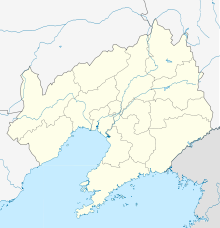Battle of Lüshunkou
This article includes a list of general references, but it lacks sufficient corresponding inline citations. (November 2012) |
| Battle of Lüshunkou | |
|---|---|
| Part of the Qing Empire 38°49′0″N 121°14′0″E / 38.81667°N 121.23333°E | |
| Result | Japanese victory |
241 wounded
7 missing
600 captured
The Battle of Lüshunkou (
Background
Following the
Chinese fortifications
The Chinese had prior to the war constructed considerable fortification on the Liaodong Peninsula.
At Jinzhou there were 4 240mm, 2 210mm and 2 150mm guns with 1,500 soldiers.[2]
Olender gives an alternate figure of 2,700 at Jinzhou.[3]
At Dalian the 5 forts/batteries had 8 240mm, 4 210mm, 6 150mm and 2 120mm guns all of the breechloading type with approximately 3,500 soldiers.[4]
At Port Arthur the Chinese defenses were considerably more extensive consisting of:[2]
| Locations | 24cm Krupp | 20cm Siege gun | 21cm Krupp | 9cm field | QF (quickfiring) | 16cm Krupp | 15cm Krupp | 12cm Krupp | Other guns or features |
|---|---|---|---|---|---|---|---|---|---|
| Tiger's tail | 3 | 2 | 24 | 4 | 6 | 4 | 2 searchlights | ||
| Erlong Hill | 10 | 13 | 1 | 2 | 4 12cm armstrong guns | ||||
| Pine-tree hill | 2 | 2 | 1 | 1 | 4 mountain guns | ||||
| Golden Hill | 3 | 2 | 8 | 2 18cm 4 9cm siege | |||||
| Total | 6 | 2 | 4 | 44 | 14 | 4 | 7 | 7 |
There were also over 50 guns and mortars of varying calibres, broadly 75-88mm of the positional and field types. This is in addition to 15 mitrailleuses and light revolver cannons. In addition 78 naval mines were present at Port Arthur[4]
The forts and Land defenses in total should have had 22,000 soldiers instead of the 14,000 maximum stationed when the fighting reached the Liaodong Peninsula.[4]
There also existed the Etse hill forts which were considered the strongest guarding Port Arthur but their contents and armaments are unknown.[2]
Jowett states that there were 220 fortress guns around Lushunkou this would indicate that the Etse hill forts contained 57 guns of varying calibres.[5]
The battle
The
The following day, on 7 November 1894 Nogi marched into the port town of
Skirmishing on the outskirts of Lüshunkou began on 20 November 1894, creating a panic among the defenders resulting in looting and destruction of property. Most of the Qing officers fled on two small boats which remained in port, leaving their men to their fate.
The assault on Lüshunkou began after midnight on 21 November 1894. Under heavy fire, the Japanese forces had stormed all of the important landward defenses by noon the following day. The shore fortifications held out a bit longer, but the final one fell to the Japanese by 1700 hours. During the night of 22 November 1894, the surviving Chinese defenders deserted their remaining positions, abandoning 57 large-caliber and 163 small-caliber artillery pieces. The fortifications, dockyards and a large supply of coal were captured largely intact by the Japanese.
When the Japanese forces entered the city, they were fired upon from houses where Chinese soldiers had hidden themselves and had put on civilian dress so as to better blend in with the local population. The Japanese responded with a house-to-house search, killing many adult males who offered resistance.
Chinese casualties were officially estimated at 4000 killed. The Japanese loses were 29 men killed, and 233 wounded.
Aftermath of the battle

The speed of the Japanese victory at Lüshunkou was regarded as a turning point in the war by contemporary Western observers and was a strong blow to the prestige of the Qing government. The Chinese government responded by denying that the naval base had fallen, and stripped Li Hongzhang of his official titles.
However, Japanese prestige over the victory was tempered by accounts of widespread massacre of the Chinese inhabitants of the city by victorious Japanese troops, allegedly in response to the torture and murderous treatment the Chinese had shown Japanese
Notes
References
- Ogawa, Kazumasa (1894). Nisshin Sensō shashinzu: A photographic Album of the Japan-China War (PDF).
- Chamberlin, William Henry. Japan Over Asia, 1937, Little, Brown, and Company, Boston, 395 pp.
- Japan An Illustrated Encyclopedia, 1993, Kodansha Press, Tokyo ISBN 4-06-205938-X
- Jowett, Philip (2013). China's Wars: Rousing the Dragon 1894-1949. Bloomsbury Publishing. ISBN 978-1-47280-673-4.
- Lone, Stewart. Japan's First Modern War: Army and Society in the Conflict with China, 1894–1895, 1994, St. Martin's Press, New York, 222 pp.
- Olender, Piotr (2014). Sino-Japanese Naval War 1894–1895. MMPBooks. ISBN 978-83-63678-30-2.
- Paine, S. C. M. The Sino-Japanese War of 1894–1895: Perception, Power, and Primacy, 2003, Cambridge University Press, Cambridge, MA, 412 pp. ISBN 0-521-61745-6
- Warner, Dennis and Peggy. The Tide At Sunrise, 1974, Charterhouse, New York, 659 pp.


